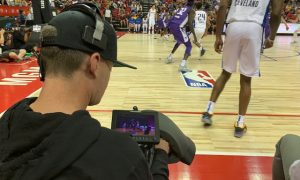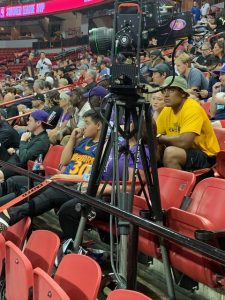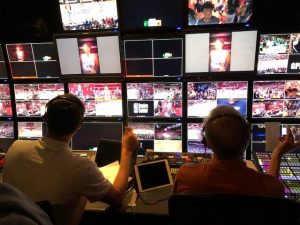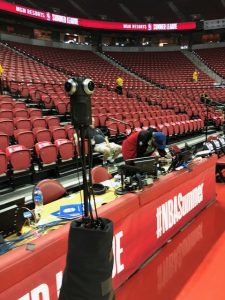2019 NBA Summer League, Part 1: The League Heads for the Next Technological Frontier
The legacy of continuing innovation rolls on in Las Vegas
Story Highlights
Every summer, the best amateur basketball players on the planet become instant superstars after being selected in the annual NBA Draft. Some who go undrafted make their presence felt moving forward. Whether you wore an expensive suit and celebrated in the green room of the Barclays Center or were dejected after your name didn’t flash on the big board, it’s time to go to work in the NBA Summer League. While these players strive to create a reputation in “The Association,” the NBA is extending its own legacy, pushing the boundaries of technology and laying operational groundwork for years to come.
“Last year, [NBA Commissioner] Adam Silver declared open season for testing,” says Steve Hellmuth, EVP, media operations and technology, NBA Entertainment. “We work in a unique partnership with Turner Sports and ESPN. We work together on things, so we share innovation, cameras, ideas, and meetings with vendors. It’s a large technical summit that is completely dedicated to basketball. The equipment gets put into place, used, reviewed, and discussed from a league perspective of how these cameras can work in the venues and what we can do to move forward together.”
MORE FROM NBA SUMMER LEAGUE
- NBA Produces World’s First 5G Smartphone Broadcast
- Data-Tracking Reaches New Heights
- ESPN Puts Flurry of Tech to the Test
Guess and Check: The League’s Blessing to Ad-Lib, Improvise
Las Vegas comes with many freedoms and liberties on its own. At the Summer League, the league takes the motto of free will and runs with it. Having seen astronomical strides in creativity at last year’s edition, the NBA has leeway throughout the 83-game schedule, which is spread over 11 days.
“As a broadcaster setting something up at a venue, you simply don’t get enough reps: once the game happens, the game’s over,” says Hellmuth. “At the Summer League, it’s a unique experience because the Thomas & Mack Center is close to NBA specifications. If something doesn’t work, we have another game coming up in minutes where we can fix it and move forward. We [also] schedule games that don’t make it to air anywhere, so they are purely for testing. We have established a platform, truck, and facility where we can fail but pick ourselves up and try again.”
While the league is spearheading initiatives to implement and test, the teams beneath the NBA umbrella are following suit.
“It’s great to see video coordinators or team [staffers] sitting on the bench and learning,” he says. “Every one of our teams get a big promotion during the Summer League, and it’s always fun and exciting to watch.”
Broadcasters are doing their due diligence as well. According to a Turner Sports spokesperson, the network is developing a new shot-clock graphic that will reside on the hardwood floor.
Cameras Above, Below, and Somewhere in the Middle
The Summer League is marked by an updated camera complement as well as the NBA’s ambition to make the viewer feel at home courtside. This year, the technical team is deploying a multitude of aerial, robotic, and handheld cameras to achieve that goal. Within the stands, a handheld operator will be positioned at a semi-low angle to provide the unique vantage point that can be experienced only by a spectator onsite.
“We’re putting someone in a seat that is about midway between the foul line and baseline, and the camera is going to be operated from the person’s lap,” says Hellmuth. “We’ll be able to get a perfect view as if you were sitting on the 25-yard line at a football game. We’ve seen that shot on social media over and over again. It’s a beautiful shot.”
About 10 rows back and 15 ft. higher, a Fletcher robo is situated to capture a similar angle and is operated with the assistance of a pan-bar for normal functionality.
From the air, the league has installed three types of robotic aerial camera systems that can be used for any given game and can even be used as the main camera feed for some of the games.
“The Spydercam offers a smoother transition and a little bit of a different look,” says Hellmuth. “We saw some things that ESPN executed on the ACC tournament that we thought went well. We’re also looking at the Supracam, which is a two-point hanging system that has been used on a number of sports. We want to see if it could possibly be a replacement for Camera 1 or [be] the ideal camera on a reverse angle to provide full coverage for our playoff games.”
Lastly, a 16 ft. JitaCam is placed under the belly of the centerhung scoreboard for the telecasts on NBA TV.
“[The JitaCam] can occupy a space that even the Spydercam can’t get to,” notes Hellmuth. “It’s something that WarnerMedia is considering for the 2020 All-Star Game in Chicago, so we’re going to test it out here and see if it works.”
Heightened Emphasis on Vertical Video
With a large youth demographic, the league is continuing its efforts experimenting with vertical video. After last year’s incarnation saw footage begin to be presented in a 16:9 format, this iteration has made significant steps in producing vertical content in a live environment.
“The experiment this year with vertical view was to see if we could do it with just a few resources, because we’re never going to have a truck or mobile unit to produce a vertical-view game,” says Hellmuth. “[For one game], we used the center graphics that are easy enough to create, but let’s just have one camera. It was similar to Mobile View [on NBA League Pass], except that it always kept the basketball in the middle of the frame. We also told the camera operator that the basketball has to always be in the center, but they have to widen [the shot] when the player goes into their shot so you can see the rim.”
Aside from using this tool in a production setting, Hellmuth and company are leveraging this way of viewing to entice millennial fans to watch the action in a traditional fashion.
“The way we’re thinking about this is that it would be a teaser,” he explains. “When a fan opens up the NBA League Pass app and sees the [vertical] Mobile View, they’ll say, ‘I really like this game, so I’m going to flip my phone horizontally to watch it.’ You’re opening the experience of the game vertically, and then there’s always the option of going horizontal.”
Tests of Augmented Reality
The physical world is not the only dimension where improvements are being made. The NBA, with the help of Supponor, is developing a cost-efficient replacement for courtside LED signage, curating it from headquarters on the East Coast.
“It’s a pure test,” Hellmuth explains. “The idea is that all of the gear, computing, and server that generates the virtual signs are back in Secaucus, NJ. The only thing we have out here in Las Vegas is the camera adapter that is collecting the data.”
The Next Frontier: Setting This Summer League Apart
With the addition of the Chinese national team (last seen at the 2007 Summer League) and the Croatian national team (making its Summer League debut), the league is constantly making decisions to enhance the product. Off the floor, the Summer League has become the place where technological ideas come to die, or perhaps live on in the regular season. And, every year, the NBA aims to develop concepts and offerings that have never been seen before.
“We don’t want to do the same things that we did last year,” Hellmuth says. “It’s always amazing how quickly our roster [of technology] gets filled because of all the innovation from the NBA vendors.”
Unlike other professional organizations, the NBA is committed to making this short exhibition tournament the birthplace of innovation that will dazzle future generations of fans.
“[Testing during the Summer League] is something that we highly value,” says Hellmuth. “A lot of the innovations that you’re going to see next year and in the coming years are a result of this incubation.”




